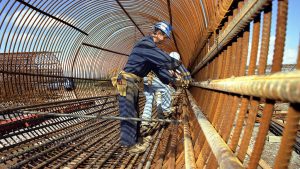A new course is being offered for anyone wanting to act as an adjudicator in construction disputes in Ontario.
Building Fundamentals for the New Construction Adjudicator, will be hosted by the Toronto Construction Association (TCA) Aug. 14 and 15 and by the Ottawa Construction Association (OCA) Aug. 27 and 28. The course is designed to give individuals the basic knowledge needed when reviewing and evaluating technical construction systems and processing related evidence provided by parties involved in an adjudication.
The adjudication system will be implemented Oct. 1 along with a prompt payment regime as part of the second phase of reforms to Ontario’s Construction Lien Act. The system will give people and businesses an alternative to going to court to resolve payment disputes.
“The way our adjudication is going to work, we anticipate, is that evidence will be provided from both parties and an adjudicator will probably, in relative isolation, make a determination on who was at fault or who is going to be responsible for settling that dispute through the adjudication process,” said Derek Smith of Constructionlab, who will be teaching the upcoming courses. “We want to be able to give them the tools that they need to be able to determine what that evidence means.”
The idea for the course came about in June because the Authorized Nominating Authority (ANA) had still not been announced, said Smith. The ANA is a new body that will oversee the adjudication process for construction disputes, including the training and qualification of adjudicators.
We are targeting lawyers, paralegals, those who will desire to become adjudicators,
— Derek Smith
Constructionlab
“We were trying to get ahead of the ball a little bit and get people prepared,” explained Smith, who sat down with TCA and OCA to discuss the matter.
“I said we have to at least get started on getting adjudicators trained on basic fundamentals of construction methods and materials. I pulled together this two-day course as an introductory session for those that have never really interfaced with construction documents, drawing terms and specification terms to at least give them a frame of reference when they are evaluating evidence submitted by parties in an adjudication dispute.”
In mid-July, ADR Chambers Inc. was selected as the successful candidate to act as the ANA. When the announcement was made, Smith reached out to encourage the ANA to consider not only the legal side of training but also the construction side.
“I reached out to ADR chambers to suggest that although we recognize that there will be some minimum training required of adjudicators, probably more so in the legal profession, we believe in the construction industry that in order for adjudicators to be seen as valid…that they have some basic construction knowledge as well,” said Smith, adding that the two sessions in Toronto and Ottawa are voluntary with no mandatory requirement yet from the ANA. “The ANA will have to establish that.”
The course will focus on vertical ICI buildings and site and is geared primarily to the legal profession and those who are not practicing construction or design on a day-to-day basis, Smith noted.
“We are targeting lawyers, paralegals, those who will desire to become adjudicators but don’t have what we consider in the construction industry to be a minimum threshold of understanding of terminology, how project teams are put together, what cause and effect there are when not necessarily strictly legal challenges occur, but also those in the supply chain through project management occur,” said Smith.
The two-day course features four modules: designers and consulting teams; reading drawings and interpreting specifications basics; construction teams, subcontractors and suppliers; and the building process — cradle to grave. Participants will study construction methods used in vertical building, including concrete frame, steel frame, wood post and beam, building envelope and site development. Building terms, building elements, site elements, electrical, mechanical and fire suppression systems will be examined in groups using a small model commercial project.
According to its description, once the course is completed participants will gain an understanding of the basics of drawings for a vertical building project in the ICI sector, terminology, drawing and specification formats and reading between scopes of work, while being able to move around drawings comfortably; gain a clear understanding of the roles and responsibilities of designers working between disciplines and who is responsible in prime versus sub consulting roles; understand the tendering process and how contracts are awarded for various scopes of work — work packages and how that relates back to a project schedule and crucial milestones; and understand where systems and communication breakdowns can occur, and the effect downstream that will have on project actors from beginning to end.











Recent Comments
comments for this post are closed